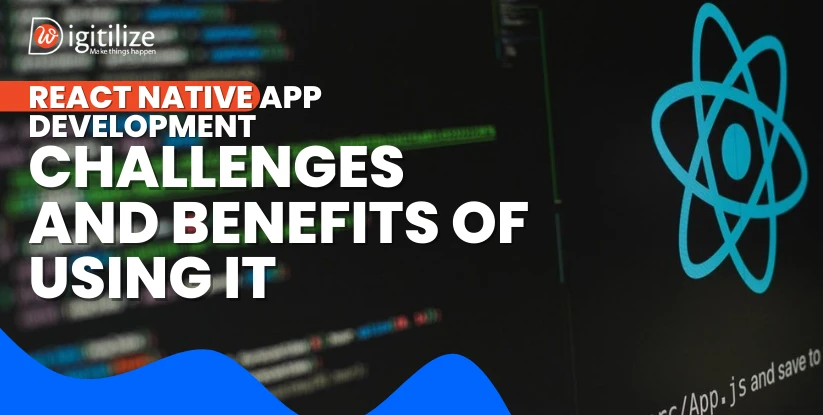React Native App Development: Challenges and Benefits of Using It

React Native remains the top choice for cross-platform development in 2025. It helps developers build native-like apps for both iOS and Android using a single codebase. You can use it to create new apps or integrate it into existing ones without much hassle.
Today, speed matters. Companies want to launch apps faster and reach a wider audience at the same time. That’s where React Native mobile app development stands out. It saves time and money. Developers write one set of code and use it across platforms. This approach reduces effort and ensures consistency.
The framework also comes with reusable components and a solid development environment. From designing the UI to testing and deployment, you can manage everything in one place. That makes the process smooth and efficient.
In this blog, we’ll share our hands-on experience with React Native. You’ll learn what to expect, what challenges to watch for, and how to make your app a success in 2025.
What is React Native?
Facebook developed the React Native programming framework, which enables developers to use the universal programming language JavaScript to create fully native mobile apps for iOS and Android. Based on the same basic building components as standard iOS and Android apps, Facebook’s React Native website describes React Native. JavaScript is used to easily link those construction components. The purpose of React Native is to make it easier for developers to reuse code on mobile and online platforms. With React Native, developers won’t have to design an identical app for iOS and Android. Alternatively, they can utilise the code reusability in React Native for all operating systems. The most remarkable thing about React Native is how little an app made with React Native and one creates with native code varies. A vast number of developers are prepared to contribute their knowledge, skills, and ideas to the framework’s improvement and upkeep, making it open-source and React Native community support-driven.Advantages of using React Native for App Development

-
Pocket-friendly and Time
With React Native, one developer can create one app, but it runs on both iOS and Android. Around 95% of the code is shared between platforms. That’s why React Native app development is so cost-effective. You don’t need two separate teams or double the budget.
React Native is packed with features that developers love. It shortens development time and cuts down costs. In the UK, many companies now prefer React Native over traditional native development. Why? Because it offers faster delivery, better cross-platform support, and lower expenses.
Native apps do offer better performance and a smoother user experience. But they also cost more and take longer to build.
One big benefit of React Native app development is that businesses can create two apps for less than half the cost of building just one native app. You don’t have to pick between iOS or Android first. You can launch both at the same time. Plus, updates and maintenance happen together, saving even more money in the long run.
-
Quick development
React Native helps mobile app developers build apps quickly and efficiently. In 2025, speed matters more than ever. Businesses want fast releases, and React Native makes that possible.
One major reason is code reuse. Developers can use the same code for both iOS and Android. This saves time and reduces extra work. Features like live updates and hot reloading also make it easy to fix bugs or make changes without restarting the whole app.
React Native comes with a rich library of pre-built components. These tools speed up the development process even more. The user interface is simple and intuitive, so developers can build clean designs with less effort.
This fast and flexible development process helps teams launch apps faster. In the competitive app industry of 2025, that’s a big win. React Native gives developers a clear edge by reducing time-to-market and boosting productivity.
This focus on quick development gives developers the ability to quickly release their apps to the market, giving them a competitive advantages of React Native in the dynamic app development industry.-
Efficient Operation
-
Strong community support
React Native is open-source. That means developers have full access to all official documentation. They can join the community and contribute whenever they want.
In 2025, the React Native community is stronger than ever. Experienced developers often guide beginners in online forums. They answer questions, share best practices, and offer code reviews.
New developers can also post their projects and get real feedback. This support helps them grow faster and avoid common mistakes.
React Native app development is not just about building apps. It’s about being part of a helpful and active developer community. That makes the learning curve easier and the overall experience more rewarding.
-
A React-like, modular, and user-friendly architecture
React Native App Development Errors to Prevent

-
Inadequate Image Enhancement
-
Console Log Statements Are Present
-
Unsuitable Redux Store Scheduling
Redux is a powerful tool in React Native. It helps manage apps efficiently. You can track app states, collect data, and store everything in one place. It also makes debugging much easier.
But to use Redux well, you need proper planning. Without it, things can get messy, especially in small apps. Redux needs you to write a lot of code, even for simple changes. That’s why it fits better with large-scale projects.
In 2025, many developers still use Redux in React Native. But they use it mainly for complex applications with heavy state management. For smaller apps, lighter tools like Context API or Zustand may be better choices.
-
Neglecting to Check External Module Codes
-
Not Giving Unit Testing Any Thought
Skipping unit tests is a common mistake in React Native development. The app might still run, but it can lead to problems later. Users may face bugs, poor performance, or unexpected issues.
Unit testing checks if each part of the app works as expected. It also makes sure components function well on their own. This helps developers catch issues early, before they reach users.
In 2025, competition in the mobile app market is tough. Apps without proper testing often fall behind. Adding unit tests improves quality, boosts user satisfaction, and makes your React Native app more reliable.
Challenges in React Native development in UK

-
Fixing and managing mistakes
-
Upgrades to React Native Versions

